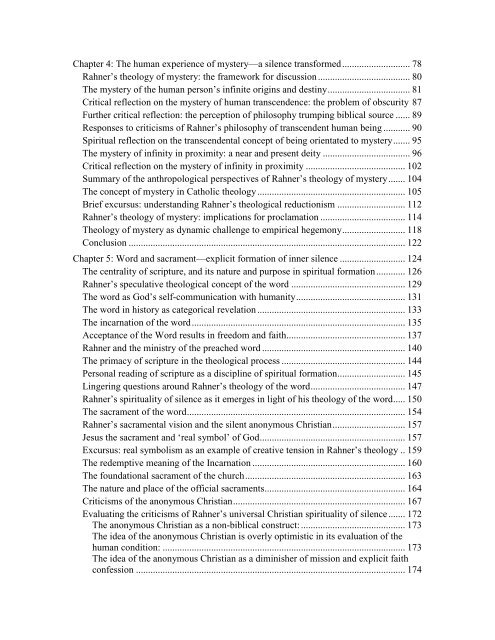Introductory notes for readers of this thesis - Theses - Flinders ...
Introductory notes for readers of this thesis - Theses - Flinders ...
Introductory notes for readers of this thesis - Theses - Flinders ...
You also want an ePaper? Increase the reach of your titles
YUMPU automatically turns print PDFs into web optimized ePapers that Google loves.
Chapter 4: The human experience <strong>of</strong> mystery—a silence trans<strong>for</strong>med ............................ 78Rahner’s theology <strong>of</strong> mystery: the framework <strong>for</strong> discussion ...................................... 80The mystery <strong>of</strong> the human person’s infinite origins and destiny .................................. 81Critical reflection on the mystery <strong>of</strong> human transcendence: the problem <strong>of</strong> obscurity 87Further critical reflection: the perception <strong>of</strong> philosophy trumping biblical source ...... 89Responses to criticisms <strong>of</strong> Rahner’s philosophy <strong>of</strong> transcendent human being ........... 90Spiritual reflection on the transcendental concept <strong>of</strong> being orientated to mystery ....... 95The mystery <strong>of</strong> infinity in proximity: a near and present deity .................................... 96Critical reflection on the mystery <strong>of</strong> infinity in proximity ......................................... 102Summary <strong>of</strong> the anthropological perspectives <strong>of</strong> Rahner’s theology <strong>of</strong> mystery ....... 104The concept <strong>of</strong> mystery in Catholic theology ............................................................. 105Brief excursus: understanding Rahner’s theological reductionism ............................ 112Rahner’s theology <strong>of</strong> mystery: implications <strong>for</strong> proclamation ................................... 114Theology <strong>of</strong> mystery as dynamic challenge to empirical hegemony .......................... 118Conclusion .................................................................................................................. 122Chapter 5: Word and sacrament—explicit <strong>for</strong>mation <strong>of</strong> inner silence ........................... 124The centrality <strong>of</strong> scripture, and its nature and purpose in spiritual <strong>for</strong>mation ............ 126Rahner’s speculative theological concept <strong>of</strong> the word ............................................... 129The word as God’s self-communication with humanity ............................................. 131The word in history as categorical revelation ............................................................. 133The incarnation <strong>of</strong> the word ........................................................................................ 135Acceptance <strong>of</strong> the Word results in freedom and faith ................................................. 137Rahner and the ministry <strong>of</strong> the preached word ........................................................... 140The primacy <strong>of</strong> scripture in the theological process ................................................... 144Personal reading <strong>of</strong> scripture as a discipline <strong>of</strong> spiritual <strong>for</strong>mation ............................ 145Lingering questions around Rahner’s theology <strong>of</strong> the word ....................................... 147Rahner’s spirituality <strong>of</strong> silence as it emerges in light <strong>of</strong> his theology <strong>of</strong> the word ..... 150The sacrament <strong>of</strong> the word .......................................................................................... 154Rahner’s sacramental vision and the silent anonymous Christian .............................. 157Jesus the sacrament and ‘real symbol’ <strong>of</strong> God ............................................................ 157Excursus: real symbolism as an example <strong>of</strong> creative tension in Rahner’s theology .. 159The redemptive meaning <strong>of</strong> the Incarnation ............................................................... 160The foundational sacrament <strong>of</strong> the church .................................................................. 163The nature and place <strong>of</strong> the <strong>of</strong>ficial sacraments .......................................................... 164Criticisms <strong>of</strong> the anonymous Christian ....................................................................... 167Evaluating the criticisms <strong>of</strong> Rahner’s universal Christian spirituality <strong>of</strong> silence ....... 172The anonymous Christian as a non-biblical construct: ........................................... 173The idea <strong>of</strong> the anonymous Christian is overly optimistic in its evaluation <strong>of</strong> thehuman condition: .................................................................................................... 173The idea <strong>of</strong> the anonymous Christian as a diminisher <strong>of</strong> mission and explicit faithconfession ............................................................................................................... 174















